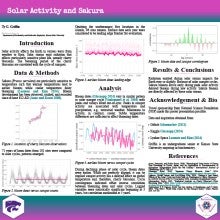Sakura and Solar Activity
Ty
Griffin
Kansas State University
Poster
Sakura and Solar Activity
Solar activity has varying effects on both weather and plants. Solar storms associated with peaks of sunspot cycles may cause greater effects. One such biological effect may be correlation between geomagnetic disturbances and the blooming period of cherry blossoms.
Sakura tree (Prunus serrulata) development has been observed, studied, and recorded over many years. By comparing the development and bloom timing with solar cycles, patterns begin to emerge. The 67 years of Sakura data and 81 years of sunspot cycle data were evaluated.
The bloom time of Sakura trees varies in similar pattern to the solar cycle . During solar cycle maximum, cherry blossoms tended to bloom earlier , while blooming later during solar minimum. Preliminary results indicate some negative or offset out-of-sync correlation between the Sakura and solar cycles .
Geomagnetic storms associated with solar cycles alter the temperature and exposure to radiation that the earth faces daily. The cherry blossoms are sensitive enough to these subtle changes that the bloom dates are either delayed or arrive earlier than normal. The trees continue to bloom sooner as the environment warms and may eventually bloom as early as the beginning of March.
Solar activity has varying effects on both weather and plants. Solar storms associated with peaks of sunspot cycles may cause greater effects. One such biological effect may be correlation between geomagnetic disturbances and the blooming period of cherry blossoms.
Sakura tree (Prunus serrulata) development has been observed, studied, and recorded over many years. By comparing the development and bloom timing with solar cycles, patterns begin to emerge. The 67 years of Sakura data and 81 years of sunspot cycle data were evaluated.
The bloom time of Sakura trees varies in similar pattern to the solar cycle . During solar cycle maximum, cherry blossoms tended to bloom earlier , while blooming later during solar minimum. Preliminary results indicate some negative or offset out-of-sync correlation between the Sakura and solar cycles .
Geomagnetic storms associated with solar cycles alter the temperature and exposure to radiation that the earth faces daily. The cherry blossoms are sensitive enough to these subtle changes that the bloom dates are either delayed or arrive earlier than normal. The trees continue to bloom sooner as the environment warms and may eventually bloom as early as the beginning of March.

Poster PDF
Poster category
Space Weather Policy and General Space Weather Contributions
Meeting homepage